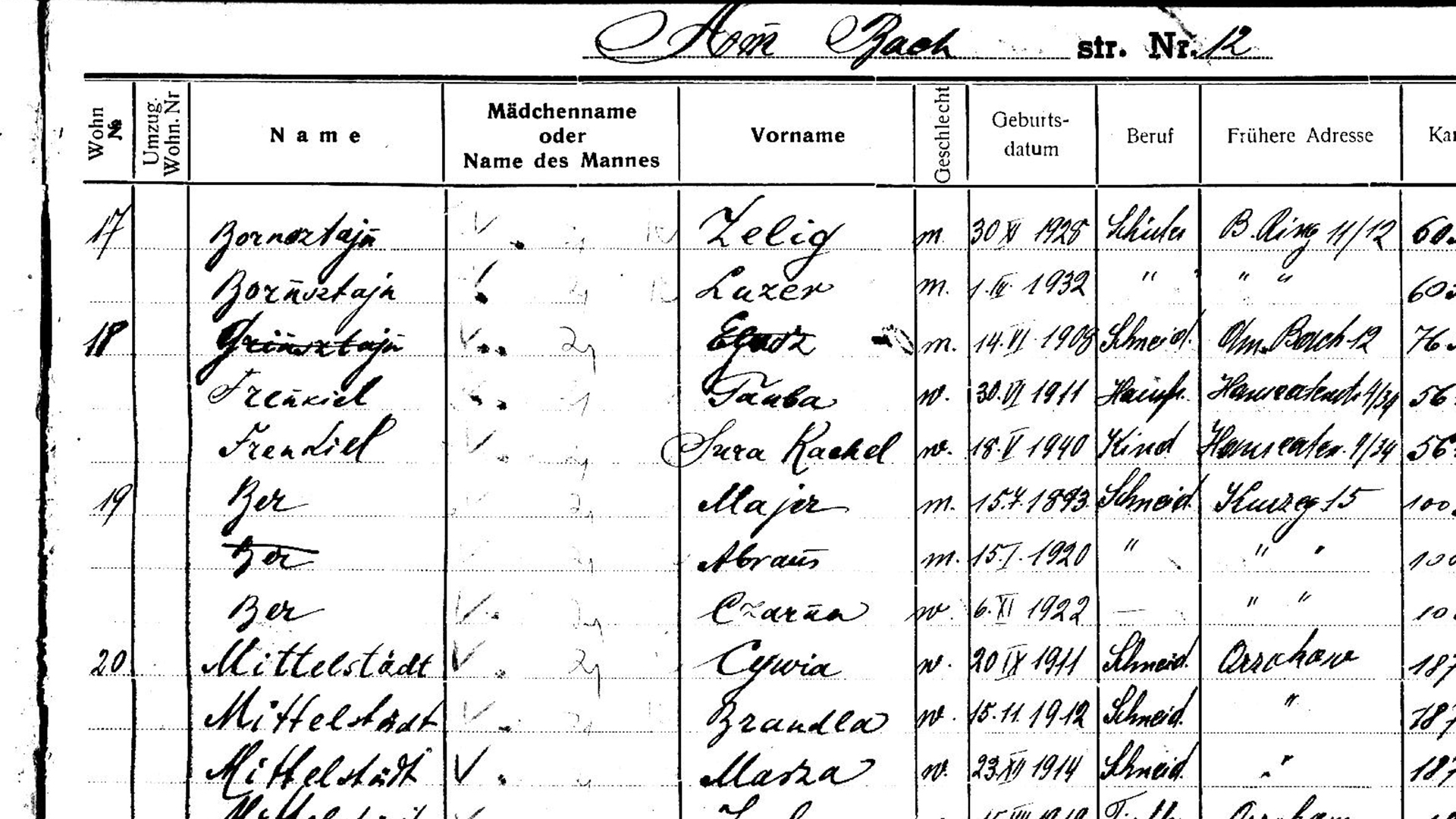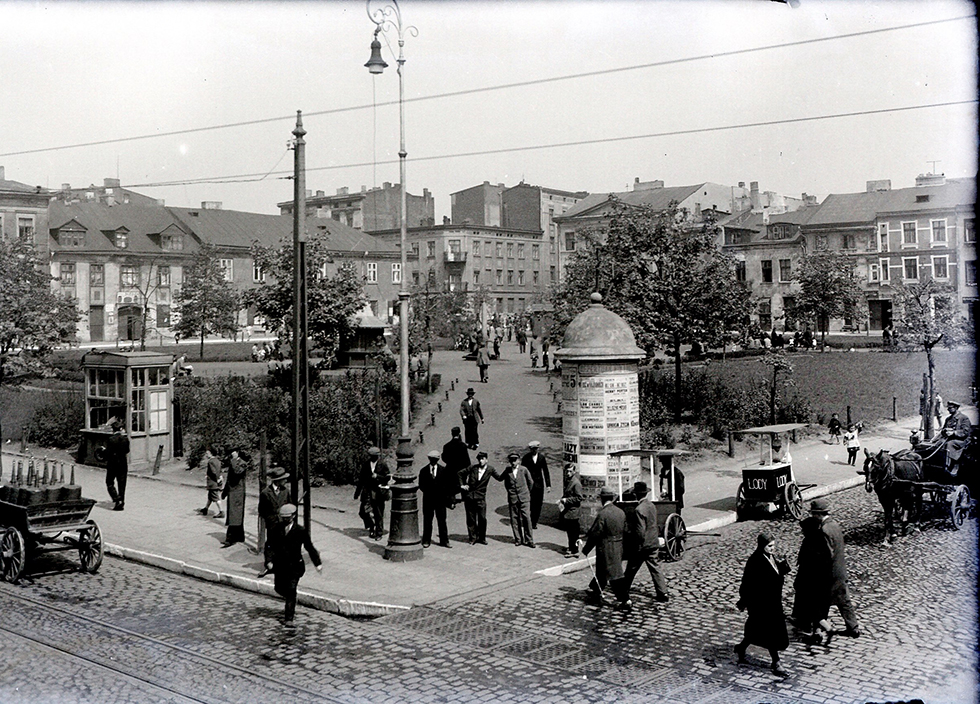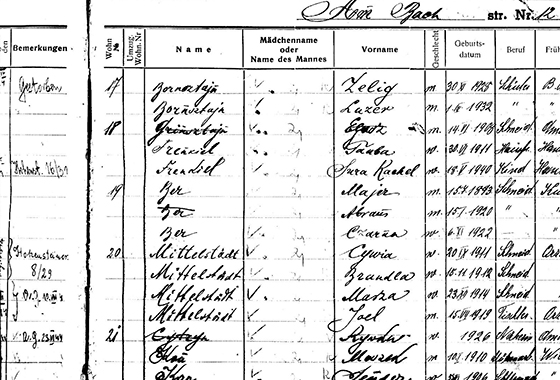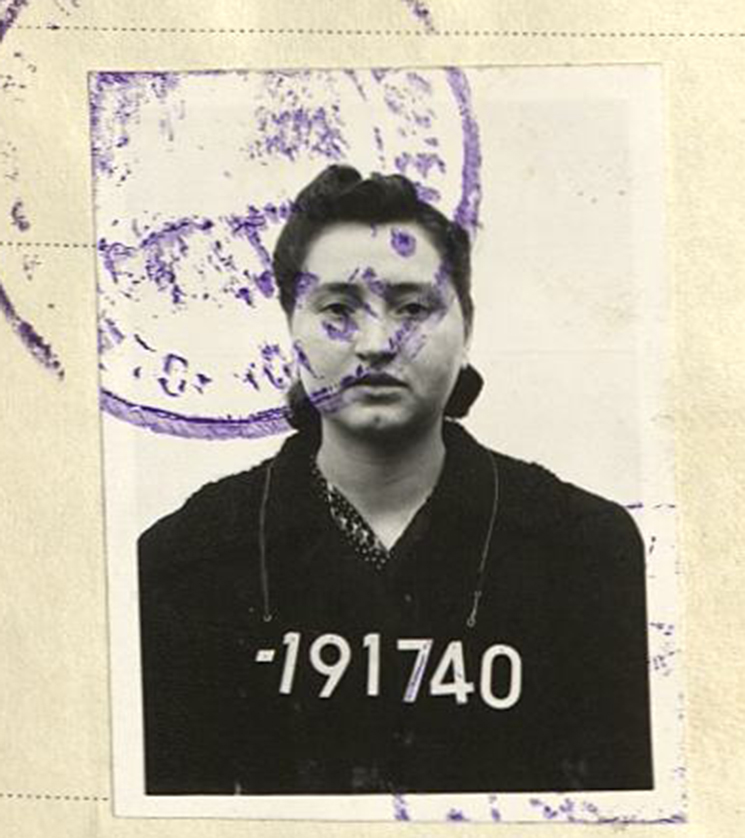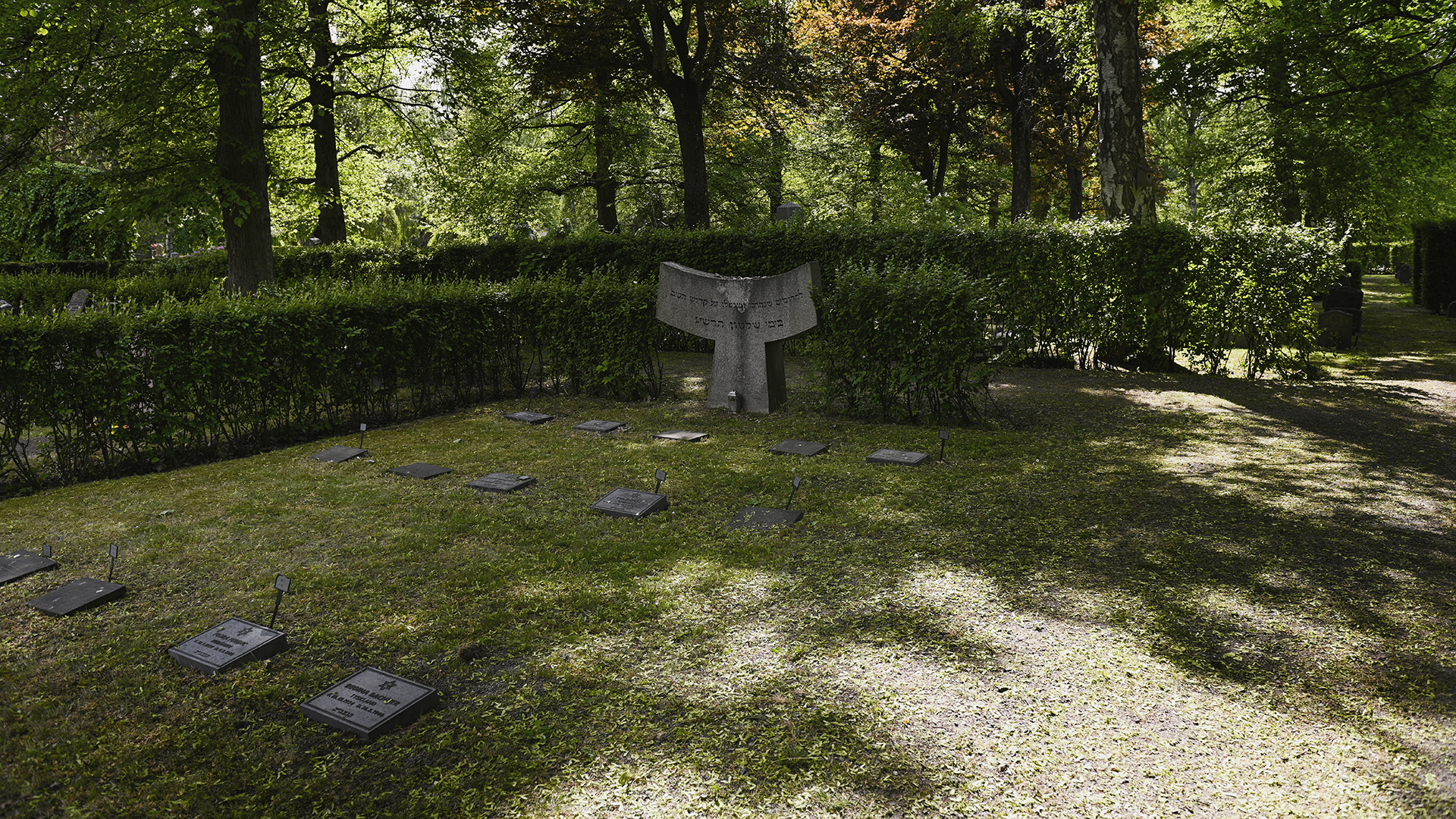In the thriving city of Łódź in central Poland over a third of the inhabitants were Jewish, like the Ber family. The city was known for its prominent textile industry and both Czarna's father Majer and her older brother Abram worked as tailors in the city. Czarna's mother Golda was a housewife while her younger brother Lejb was still at school. Czarna herself was completing her education when German troops marched into Łódź in September 1939.
After a few months the city's Jews were forced into a ghetto established in the poor and run-down Bałuty neighbourhood. Unfortunately, we do not know where in Łódź the Ber family lived before the ghetto was established, but they were probably one of thousands of Jewish families forced to move into the ghetto in January 1940. The Ber family moved into a small apartment on Krotka Street (Kurzgasse), close to the centre of the ghetto. In addition to Czarna, her parents and two siblings, the apartment also housed two boys, Szulem and Icek. They have the same surname as Czarna’s mother Golda had before she married (Frum) and it seems that the two boys were Czarna’s cousins, who were now being cared for by the Ber family.
Every part of the old and run-down neighbourhood was filled with up to tens of thousands of Jews. Hunger and cold prevailed, while disease spread in the crowded houses. Executions took place publicly in the streets and the ghetto continued to be filled with people from different parts of occupied Europe. Łódź's famous industries were the lifeline of the ghetto and most of its population was forced to work in them. Only those who worked or went to school, like Czarna's younger brother Lejb and his relative Icek, were allowed to receive food rations, which the Nazis constantly reduced. Icek died in the ghetto in June 1942, at the age of eight.
Despite great misery and starvation, life in the ghetto continued at least until the afternoon of the September 5, 1942, when the Germans imposed a ghetto-wide curfew that lasted several days. The Germans went from house to house, apartment to apartment, with lists of the ghetto's inhabitants, selecting all those they no longer considered fit for work. On September 7, the soldiers reached the Ber family's apartment. They choose Czarna's mother Golda, her little brother Lejb and young relative Szulem. That was the last time Czarna saw them.
The list of apartments shows that their names were crossed off. Along with thousands of others, Czarna’s mother, brother and young relative were taken to Radogoszcz (Radegast) railway station at the northern edge of the ghetto. There they were loaded onto freight wagons that took them to the Chełmno extermination camp where they were murdered in gas vans. Around 180,000 people were murdered in Chełmno. Golda was 46 years old when she was murdered. Czarna’s brother Lejb was only 14 and Szulem just 10 years old when the Nazis brutally murdered them.
Czarna remained in the ghetto with her father Majer and older brother Abram and had to continue working there to survive. In the summer of 1944, Abram died of tuberculosis. Czarna and her father were now among the remaining 70,000 people in the ghetto, which at its peak had a population of nearly 210,000. The Soviet success on the Eastern Front and the uprising in the Warsaw Ghetto by its remaining Jews led the Nazis to empty the Łódź Ghetto and deport its inhabitants in August 1944.
Czarna, Mejer and other residents were deported in railway wagons, from the same station their families had been sent to die, to the Auschwitz-Birkenau concentration and extermination camp. Upon arrival, the majority was sent directly to the gas chambers, and while Czarna and Majer both seem to have survived selection they were separated. They never saw each other again. Majer was apparently sent on to Dachau concentration camp and it is unclear what happened to him. He may also have been sent back to Auschwitz but the trail stops and we don't know his fate.
Czarna remained in Auschwitz for ten days before being sent to a labour camp to work in an ammunition factory. She later stated in an interview that the camp was called Neuken, but it remains unclear which camp it actually was. It could have possibly been a satellite camp of one of the larger concentration camps, such as Gross-Rosen, Buchenwald or Ravensbrück. Czarna later told us that she was sent back to Ravensbrück after nine months in the camp, perhaps indicating that the munitions factory was linked to Ravensbrück.
Liberation an the time in Sweden
As the Allied forces approached, the Germans began evacuating the concentration camps in the east, forcing the prisoners westwards and further into Germany. Many prisoners who were forced on the so-called death marches in the harsh cold of January and February died. Those who survived were sent to new concentration camps, most notably Bergen-Belsen. The Ravensbrück camp began to be evacuated in April 1945, when rescue came in the form of white buses from the Swedish Red Cross.
Czarna was one of 7,000 women, the vast majority of them non-Jewish, rescued from Ravensbrück in white buses. She arrived in Malmö on the April 28, 1945, and was the only surviving member of her family. Czarna ended up in a refugee camp in Doverstorp, near Norrköping, and she began to rebuild her life. She applied for a work permit for a factory job in Motala at Engelfabrikerna, certifying that she was in good health. The labour office in Doverstorp helped her get some clothes.
However, we do not know whether Czarna started working in the factory before she became ill. As early as February 1946, she was admitted to Söderby Hospital, south of Stockholm. She seems to have remained in various hospitals and on reapplying for a residence permit in Sweden in 1950, she was listed as being admitted to Sundby Hospital in Strängnäs. Here it is noted by hospital staff that "the applicant is insane". We know no more details about Czarna's mental illness. It is most likely a consequence of the trauma she experienced during the war. However, she is the only survivor buried in the Northern Jewish Cemetery to be described this way.
Czarna died in Sundby Hospital on the February 20, 1950, aged 26. In the Jewish community's grave books, we see that she died from tuberculosis. Czarna appears to be the only member of her family to survive. Apart from traces in the archives, no relative has registered her as missing. Had it not been for the passport photo she submitted with her residence permit application we might never have known what she looked like.
Czarna's route
The map shows the places Czarna was forcibly transferred or travelled to, from Łódź where she was born to the Northern Jewish Cemetery. Click on the information symbol to see all the locations, listed in chronological order.
About Czarna Ber
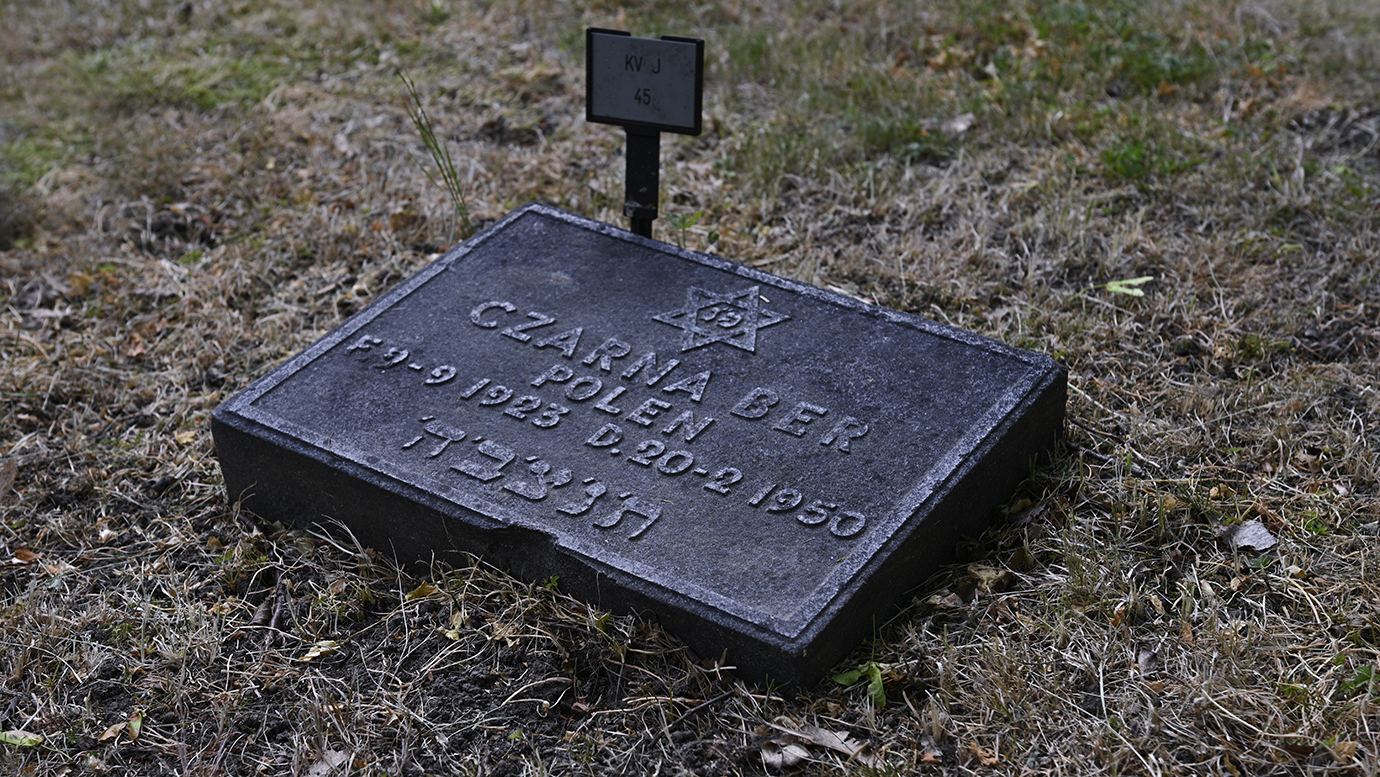
About Czarna's father Majer Ber
About Czarna's mother Golda Ber
About Czarna's brother Abram Ber
About Czarna's brother Lajb Ber
About Czarna's young relatives
Learn more about the fates of other
Here you will find links to the "Förlorade röster" [Lost Voices] collection page as well as links to all the personal texts, listed by surname.
